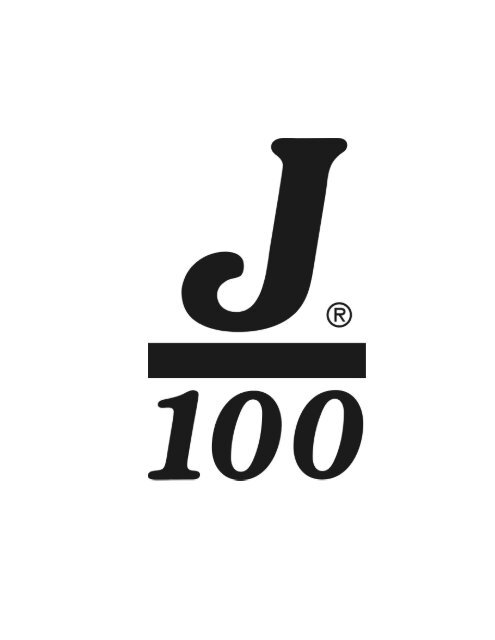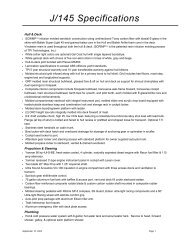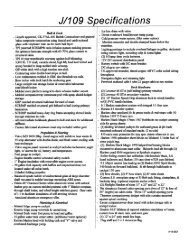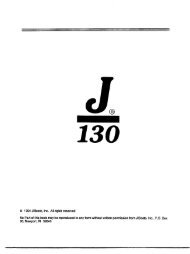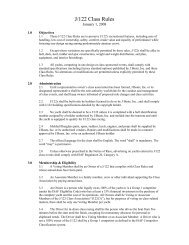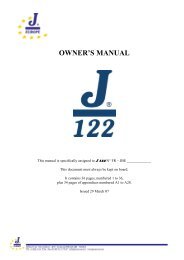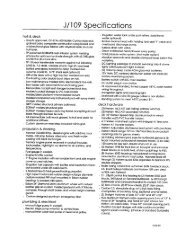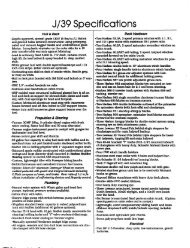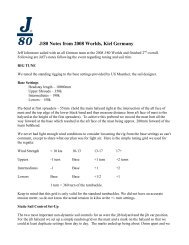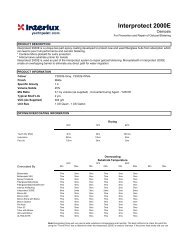J100 Owner GuideHull57on.pdf - J/Owners
J100 Owner GuideHull57on.pdf - J/Owners
J100 Owner GuideHull57on.pdf - J/Owners
Create successful ePaper yourself
Turn your PDF publications into a flip-book with our unique Google optimized e-Paper software.
J/100 OWNER MANUAL 3Table of ContentsIntroduction........................................................................................................................................................................ 4Optional CE Certification ................................................................................................................................................. 4Specifications.................................................................................................................................................................... 7Important Contacts........................................................................................................................................................... 8Commissioning Checklist ............................................................................................................................................... 9Getting Started With Your J/100 ...................................................................................................................................10Diagrams, Layouts, & Schematics...............................................................................................................................14Deck Hardware Layout .................................................................................................................................................14Mainsheet & Traveler Diagram.....................................................................................................................................15Halyard Layout ..............................................................................................................................................................16Reefing System Diagram..............................................................................................................................................17Steering System ............................................................................................................................................................18Engine & Exhaust System Layout................................................................................................................................19Fuel System Layout ......................................................................................................................................................20Thru-Hull Locations .......................................................................................................................................................21Optional Water System Layout.....................................................................................................................................22Head & Holding Tank Schematic..................................................................................................................................23Main DC Distribution Panel...........................................................................................................................................24DC Component Layout & Schematic...........................................................................................................................25Bonding System ............................................................................................................................................................26Tuning The Rig ................................................................................................................................................................27Engine System ................................................................................................................................................................28Sail Drive........................................................................................................................................................................28Fuel System...................................................................................................................................................................28Engine Cooling System ................................................................................................................................................28Exhaust System ............................................................................................................................................................29Engine Safety Precautions ...........................................................................................................................................29Fueling ...........................................................................................................................................................................30Engine Maintenance .....................................................................................................................................................31Plumbing Systems..........................................................................................................................................................32Optional Water System.................................................................................................................................................32Thru-Hulls & Seacocks .................................................................................................................................................32Pump System................................................................................................................................................................32Head System.................................................................................................................................................................32Electrical System ............................................................................................................................................................33DC Electrical System ....................................................................................................................................................34Safety ................................................................................................................................................................................35Maintenance Tips............................................................................................................................................................37Annual Maintenance Checklist.....................................................................................................................................39Storage Tips.....................................................................................................................................................................40Pearson Composites, LLC Limited Warranty..........................................See Warranty Package Included with Boat
J/100 OWNER MANUAL 4IntroductionWELCOME ABOARD and welcome to the J/Boats family of owners. Your boat is designed and engineered to bethe strongest, best performing, easiest-to-use, and most comfortable sailing boat of its type.Sailing involves risk, most of which can be minimized with advance planning and proper seamanship. The J/100owner should become proficient in all aspects of handling the vessel under sail and power, and be well versedwith emergency procedures before undertaking any offshore passage. The owner is further responsible for anyrequired state registration or federal documentation, accident reporting, outfitting the vessel with proper safetyequipment, and the safe operation of the vessel. J/Boats is happy to refer the owner to Boating Safety Courses orother seminars available.Please be sure to complete the enclosed warranty card and mail to Pearson Composites, LLC.This manual is furnished for your benefit, but shall in no way be construed as any sort of warranty or contract,express or implied, creating any obligation on the part of J/Boats, Inc., with respect to any fact or facts or anyadvice or opinions contained herein. The sole and exclusive warranty of the product is the Pearson Composites,LLC. Warranty described in the appendix hereto and on the Warranty Card furnished with the yacht.J/BOATS, INC. HEREBY DISCLAIMS ANY AND ALL WARRANTIES, EXPRESS OR IMPLIED, INCLUDINGANY WARRANTY OF FITNESS FOR A PARTICULAR PURPOSE OR ANY IMPLIED WARRANTY OFMERCHANTABILITY.Optional CE Certification for European Countries:J/Boats offers CE Certification for European Countries as a factory option. Please read the following detailsconcerning this certification.CE Design Category:• With standard equipment (no lifelines) = J/100 Meets Category C* Requirements for CE Certification andmeets Category A stability requirements. Boats built by Pearson Composites and shipped to Europecarry the Category C builder plaque.CE Certification Notice:This manual has been compiled to help you to operate your J/100 with safety and pleasure. It containsdetails of the J/100, the equipment supplied or fitted, its systems and information on its operation. Pleaseread it carefully, and familiarize yourself with the craft before using it.Even when your boat is categorized for them, the sea and wind conditions corresponding to the designcategories A, B, and C range from strong gale to severe conditions, open to the hazards of a freak wave orgust, and are therefore dangerous conditions, where only a competent, fit and trained crew using a wellmaintained boat can satisfactorily operate.Ensure that the anticipated wind and sea conditions will correspond to the design category of your boat, andthat you and your crew are able to handle the boat in these conditions.
J/100 OWNER MANUAL 5This owner's manual is not a course on boating safety or seamanship. If this is your first boat, or you arechanging to a type of boat you are not familiar with, for your own comfort and safety, please ensure that youobtain handling and operating experience before "assuming command" of the boat. Your dealer or nationalsailing federation or yacht club will be pleased to advise you of local sea schools, or competent instructors.This owner's manual is not a detailed maintenance or trouble shooting guide. In case of difficulty, refer to theboatbuilder or its representative. Always use trained and competent people for maintenance, fixing ormodifications. Modifications that may affect the safety characteristics of the craft shall be assessed,executed and documented by competent people. The boatbuilder cannot be held responsible formodifications he has not approved.NOTE: Any change in the disposition of the masses aboard may significantly affect the stability, trim and performance ofyour boat. Users of this boat are advised that:• All crew should receive suitable training;• The boat should not carry more than the manufacturer's recommended load;• Bilge water should be kept to a minimum;• Stability is reduced by any weight added high up;• In rough weather, hatches, lockers and doorways should be closed to minimize the risk offlooding;• Stability may be reduced when towing or lifting heavy weights using a davit or boom;• Breaking waves are serious stability hazard.In some countries a driving license or authorization are required, or specific regulations are in force.Always maintain your boat properly and make allowance for the deterioration that will occur in time and as aresult of heavy use or misuse of the boat.Any boat – no matter how strong it may be, can be severely damaged if not used properly. This is notcompatible with safe boating. Always adjust the speed and direction of the craft to sea conditions.If your boat is fitted with a liferaft, read carefully its operating manual. The crew should be familiar with theuse of all safety equipment (harness, flares, liferaft, etc.) and emergency maneuvering (man overboardrecovery, towing, etc), sailing schools and clubs regularly organize drill sessions.PLEASE KEEP THIS MANUAL IN A SECURE PLACE, AND HAND IT OVER TO THE NEW OWNER WHENYOU SELL THE CRAFT.Definition of CE design category:Category C: A boat given design category C is considered to be designed to operate in winds up to Beaufort force 6 and theassociated wave heights (Significant wave height up to 2 m, see note below). Such conditions may be encountered onexposed inland waters, in estuaries, and in coastal waters in moderate weather conditions.NOTE The significant wave height is the mean height of the highest one third of the waves, which approximately correspondsto the wave height estimated by an experienced observer. Some waves will be double this height.Stability & Loading:A maximum total load has been used for assessing stability and bouyancy comprising
J/100 OWNER MANUAL 6J/100 Recommended LoadingMaximum Crew = 7 People at 75 kg (165 lbs) each.Manufacturer's Recommended Maximum Load = 884 kg (1,948 lbs) - includes crewThis assessment has been made assuming that all standard equipment is aboard and that the boat in light craft condition has amass of 2,948 kg. (6,500 lbs.) This recommended maximum load takes into account the mass of the following:a) The number of persons onboard: Where children are carried as part of the crew the maximum number of persons may beexceeded provided that each child's mass does not surpass a limit of 37.5 kg (83 lbs) and the total persons mass (75 kg) is notexceeded.b) basic equipment mass of (LH-2.5)^2 considered not to be less than 10kg.c) stores and cargo (if any), dry provisions, consumable liquids [not covered by d) or e)], and miscellaneous equipment notincluded in the light craft mass or in b);d) consumable liquids (fresh water, fuel) in portable tanks filled to the maximum capacity;e) consumable liquids (fresh water, fuel) in permanently installed tanks filled to the maximum capacity;f) a liferaft or dinghy when intended to be carried.This boat has been assessed using the Stability Index (STIX), which is a measure of the overall stability safety and considersthe effects of boat length, displacement, hull proportions, stability characteristics and resistance to downflooding. Thisassessment has yielded the following data:J/100 Minimum Operating Condition:• STIX = 37.17• Angle of Vanishing Stability = 133.70 degreesJ/100 Loaded Displacement Condition:• STIX = 32.02• Angle of Vanishing Stability = 126.30 degreesJ/100 therefore qualifies for Category A stability requirements.
J/100 OWNER MANUAL 7SpecificationsMODEL J/100LOA (Lh)LWLBeam (Bh)10.0m (32.80')8.839m (29.00')2.819m (9.25')Draft : [Max Loaded Draft] 1.753m (5.75') : [1.784m (5.85’)]BallastBallast TypeDisplacement (std boat)1,111 kg (2,450 lbs.)Cast lead strengthened with 5% antimony2,948 kg (6,500 lbs.)100% Sail Area 44.4 sq m (478 sq ft)IM11.734m (38.50')ISP 13.106m (43.00’)JPE3.505m (11.50')11.582m (38.00')4.115m (13.50')Headstay Pin to Pin Length 12.103 m (40’ 0-1/2” )Recommended Step LocationEngineFuel Capacity*Engine AlternatorHouse Battery Capacitymast step slot centered around standard bolt locationYanmar 2YM15 ,14hp, Saildrive45.42 liters (12 US gallons)60 amp standard Yanmar marine alternator95 amp hoursStandard Propellor GORI geared folding prop 15” x 11”Battery TypeHolding Tank CapacityWater Capacity**Limit of Positive Stability (mMOC)Hull & Deck Core MaterialHull & Deck Molding ProcessHull Blister WarrantyMast Height Above WaterAGM Glass Mat45.4 liters (12 gal.)18.9 liters (5 US gallons) opt.ional133 degreesBaltek® CK-57 AL600 End-Grained BalsaSCRIMP® Resin Infusion10 Years: <strong>Owner</strong> Transferable14.04 m (46’ 0-7/8”) not including masthead instrumentsDisplacement/Length Ratio 119Sail-Area/Displacement Ratio 22CE Mark Design CategoryRecommended PHRF RatingCategory C81 Base (w/150% genoa & symmetrical chute)*Fuel capacity may not be completely usable depending upon trim and loading of the craft and a 20% reserve should be kept on board.**All water capacity may not be usable depending upon trim and loading of the craft.
J/100 OWNER MANUAL 9Commissioning ChecklistPre-Launch___ Read equipment owner manuals___ Pre-rig mast and check installation of:• halyards• blocks• electronics• shrouds• spreader chafe guards• lifeline pins___ Pre-rig boom___ Bottom painted or touched up___ Check propeller/zinc___ De-winterize engine and check status of:• engine oil/ filter• coolant level• transmission fluid level• water intakes/filter• fuel lines/filter___ Check battery charge___ Check all hose clamps, tighten as required___ Close all seacocksLoose Gear___ Fenders and lines___ Dock lines___ Winch handles___ Ignition keys___ Bilge pump handles___ Mast wedges/Spartite lubed___ Double-check sling locations and markLaunch___ Check for leaks___ Check seacocks___ Check engine seal for leaksEngine Start___ Read engine owner’s manual___ Open raw water valve on Saildrive leg___ Start engine___ Check exhaust for cooling water flow___ Check oil press., water temp., charging gauges___ Check transmission- forward/reverse___ Check transmission leg sealStep Mast___Locate mast step plate in middle of adjustment rangeand tighten bolts.___ Hoist spar and lower into boat___ Attach furler to stemhead fitting___ Attach hydraulic cylinder to backstay___ Attach all shrouds and hand tighten___ Dock tune shrouds___ Dealer to Install and pour Spartite wedge kit___ Run and connect mast junction box wiresRigging___ Install boom___ Lead all halyards to stoppers on cabin top___ Rig reef lines___ Install and connect boom vang___ Rough tune spar per tuning guideSystems Check___ Fill fuel tank___ Check operation of electrical systems and pumps___ Check sailing electronicsTrial Sail___ Raise and lower sails to check for fit___ Monitor engine performance___ Check bilge for leaks___ Check sailing electronics
J/100 OWNER MANUAL 10Getting Started With Your J/100Generally, your dealer or commissioning yard will help you prepare your boat before launching. And inmost instances they will undertake the entire commissioning job. They are experts in the field and arecapable of completing most commissioning tasks.Before ProceedingBefore you begin to assemble your new boat you should become familiar with the different sail controlsystems and associated hardware. All running rigging and loose deck hardware items are shipped from thefactory in parts boxes complete with part inventory sheets. To help you properly install these items pleaserefer to the rigging and hardware sections and diagrams in this guide.The Commissioning Checklist: will help you double check that the J/100 is assembled properly and allsystems and rigging are functioning properly. If a boatyard other than an authorized J/Boat dealer isperforming the work, review this list with them to establish what needs to be done and by whom.Topsides: wash off all dirt and grime accumulated from delivery. Use only non-abrasive cleansers on thegelcoat. Then apply a coat of high quality car or boat wax or use a synthetic poly-based coating. Eitherfinish will prolong the life and sheen of the gelcoat.Bottom: preparation is critical to long-lasting enjoyment. To ensure a professional finish, carefully reviewthe paint manufacturer’s recommendations for preparing the bottom and have your dealer roll it or spray iton. Be sure that there are a MINIMUM of 4 coats of epoxy primer covering the keel and rudder prior to finalcoating of bottom paint.Chainplates: are machined of polished stainless steel. Each shroud fitting is mounted to the deck andthrough-bolted to the primary structural bulkhead in the main salon. The backstay chainplate is throughbolteddirectly to a reinforced area of the transom.Stemhead Fitting: is a custom polished stainless fabrication. The stem head fitting is designed towithstand all headstay loads, and is attached to a structural bulkhead below the deck.Mast Collar: is a custom stainless fitting and incorporates stainless pins for halyard and reefing line turningblocks. Spartite is used to wedge the mast from this collar. This wedge should be installed/poured into theinterface with the mast collar and with the mast after the appropriate initial tuning of the mast isaccomplished. The rubber mast boot then fits over the flange of the collar to help seal the interior.Toe Rail: is a full length teak rail (plastic optional) with custom forward and mid-ship chocks.Optional Stanchions & Pulpits: are designed for proper offshore safety as well as to facilitate access tothe boat. Included are two lifeline gates to port and starboard and a stern boarding gate. All stanchions are1” diameter stainless steel and are secured into their custom designed bases with machine set screws.Optional Lifelines: are SS wire in accordance with ORC safety regulations and are fastened at either endby stainless forks and turnbuckles. Each lifeline is clearly marked from the factory and is intended to fit aspecific portion of the lifeline/stanchion system. The installation follows:• Insert all lifeline gates/stanchions into the sockets provided along the edge of the deck. Secure eachstanchion in place by tightening the two set screws in each base. We recommend that you dip thescrews in blue Loctite or sealant before securing, so they don’t work themselves loose over time.• Install all lifelines without tightening the turnbuckles. Remove the eyes at the ends of the lifelines andthread them through in the stanchions. If the boat is equipped with the optional lifeline pads, thread the
J/100 OWNER MANUAL 11lifeline through these prior to attaching to stern rail. The longer lifeline pad will be sized for the upperlifeline and the shorter for the lower lifeline.• Finish off the job by tightening the turnbuckles, adjusting the lifeline gate pendants for the proper length,and taping off the turnbuckle “split rings” (or cotter pins) for a finished appearance.Skylight Ventilation Hatch: is made of extruded anodized aluminum and scratch-resistant acrylic cover.The hatch comes equipped with a ventilation position and 180 degree articulation.Ports: are of painted aluminum frames with scratch-resistant acrylic and arrive “ready-to-use”.DO NOT PERMIT ACETONE OR OTHER HARSH CLEANSERS TO GET ON PORTS, OR HATCHESAS THEY MAY DAMAGE THE FINISH & CLARITY OF SOME DECK HARDWARE.Deckhouse Handrails: Stainless handrails are standard for secure maneuvering and ease ofmaintenance.Winches: Standard winches are aluminum self-tailing models from Harken Yacht Equipment. The locationof these winches facilitates sailing with one or two aboard. Each is geared to match the load requirementsof the specific task.J/100 Steering SystemThe steering system is carefully engineered to provide finger-tip control. This is achieved by utilizing rudderhigh quality bearings and steering system components.Tiller: is a laminated varnished teak tiller with custom stainless tiller head design.Rudder Shaft: is made of carbon fiber and engineered to exceed ABS Offshore Yacht Scantlings. The e-glass rudder is engineered to withstand tremendous shear loads in ocean conditions.Optional Rudder Shaft Seal: is located at the top of the lower rudder bearing. It is a simple seal designthat prevents water from entering the hull. (part of optional autopilot prep package).J/100 RiggingThe running and standing rigging items supplied with your boat are designed for efficiency. A wealth ofracing and cruising experience has gone into the deck layout to make sailing and boat handling safe andeasy to handle by a couple or a racing crew.• Harken Headsail Furling: A standard Harken Furler is provided with the boat and requires assemblyprior to installing the mast. A complete instruction manual is included with this hardware detailing theprocedure. The pin-to-pin headstay length necessary to complete this task for the J/100 is 12103mm or39’ 8-1/2”.• Mast: Rigging the J/100 mast is a common procedure, and best handled by a qualified marine rigger.All spreaders, shrouds, and halyards are installed and properly taped and secured. Be sure all mastrelated electronics and wind indicators are properly wired and installed prior to stepping the mast. Afterstepping the mast it is VERY IMPORTANT to properly brace the mast within the mast collar prior tosailing with a rubber mast wedge. The J/100 is shipped with Spartite for this purpose. We alsorecommend that a small cord is tied and taped approx. 24” above each lower spreader between theintermediate shroud and upper shroud if you plan on sailing with any type of spinnaker. Simply tie thisline to each shroud (allowing for some slack) and tape ends over with rigging tape. This prevents the a
J/100 OWNER MANUAL 12spinnaker (during a take down) from potentially dropping into the V that is formed at the lower spreaderbetween these shrouds.• Hydraulic Backstay: The J/100 is equipped with a new remote hydraulic backstay from Sailtec to helpyou fine tune your rig and sails for optimum performance. This hydraulic unit is simple to operate, easyto maintain, and highly reliable. The cylinder is affixed at its lower end to the tang on the transom andat its upper end to the eye at the end of the backstay. In order to make the cylinder fit, you mustrelease the valve and pull out the SS shaft to fully extend it. The location of the panel at the aft end ofthe cockpit allows simple adjustment of backstay tension while seated in the cockpit. Please refer to theSailtec instructions for proper maintenance and operation of the system.• Boom: Run the reef lines so the red line (port) is led through the port sheaves and the green line(starboard) is led through the starboard sheaves at both the outboard end and the gooseneck. Thestarboard reef doubles as the cunningham.• Boom Vang: The Hall QuikVang is a mechanically operated spring loaded boom vang with a Harkenblock and tackle purchase system. This vang system allows for quick and easy adjustment and alsoacts as a boom topping lift. The vang is affixed to the vang plate welded underneath the boom and tothe mast at the vang gooseneck located just above the mast collar. See the QuikVang operatinginstructions for how to adjust the internal spring for best results.Sail Control SystemsAfter stepping the mast and connecting the boom, QuikVang, Harken furler, and integral backstay, rig allhalyards and the remaining sail control systems on deck.• Main Halyard: exits the mast on the port side, runs through a turning block at the mast collar, throughthe middle port organizer block and then aft through the inboard port rope clutch and finally to thewinch. The tail end is stored in a supplied line bag to be mounted outboard and forward of the ropeclutch.• Jib/Genoa Halyard: exits the mast to port, leads through a mast base block, aft to the outboard ropeclutch to port and the tail stores in line bag.• Spinnaker Halyard: exits the mast to starboard, lead through mast base blocks, aft to the outboardforward rope clutch starboard and the tail stores in line bag.• Mainsheet Traveler: is a Harken low friction system. The purchase system on each side controls aHarken windward sheeting car mounted on the track (see diagram).• Outhaul: is adjusted at the cleat on the underside of the boom and comes pre-assembled from HallSpars.• Cunningham: The cunningham doubles as the starboard reef line. To set it up as a cunninghamsimply tie a knot at the boom end tail of the reef line. The line leads forward to the sheave at thegooseneck, up to the cunningham block with S.S. hook back down through a fairlead on the mast,down to the mast base block, through the organizer and aft to the inboard stopper.(see diagram). Touse the continuous reef system simply run the boom end tail through the clew reef grommet, backdown around the boom and tie a bowline.• Mainsheet: is a 6:1/24:1 system (see diagram) with 6:1 rough tune and 24:1 fine tune. The system isdesigned to allow easy and quick adjustments of the mainsheet. The location of the traveler andwinches also facilitate single-handed sailing and adjustments.
J/100 OWNER MANUAL 13• Jib/Genoa Sheet: attaches to the roller-furler headsail by a simple bowline knot, leads to the jib/genoablock on the track, aft to the turning block on the cockpit coaming and then to the primary winch.• Optional Spinnaker Gear: The J/100 has standard fold-over padeyes installed standard for spinnakersheet and tack line blocks (5 total) the spinnaker blocks are optional. See the deck hardware layoutdiagram for more info.
J/100 OWNER MANUAL 14Diagrams, Layouts, & SchematicsDeck Hardware Layout
J/100 OWNER MANUAL 15Mainsheet & Traveler Diagram
J/100 OWNER MANUAL 16Halyard Layout
J/100 OWNER MANUAL 17Reefing System Diagram
J/100 OWNER MANUAL 18Steering System
J/100 OWNER MANUAL 19Engine & Exhaust System Layout
J/100 OWNER MANUAL 20Fuel System Layout
J/100 OWNER MANUAL 21Thru-Hull Locations
J/100 OWNER MANUAL 22Optional Water System Schematic
J/100 OWNER MANUAL 23Head & Holding Tank Schematic
J/100 OWNER MANUAL 24DC Distribution Panel
J/100 OWNER MANUAL 25DC Component Layout & Schematic
J/100 OWNER MANUAL 26Bonding System
J/100 OWNER MANUAL 27Tuning The RigTuning the MastFollowing is a general guide to tuning your J/100 mast. Please consult your sailmaker for “fine-tuning” the mastto match the sails.With the standard length J/100 headstay and the mast step situated in the middle, the mast rake (as measuredfrom the back of the mast at deck level to a plumb on the main halyard should be approximately 24 inches.The upper shrouds are attached to the outer chainplate hole. The lowers are connected to the inner hole. Theintermediates are secured in the forward hole. Begin by hand tightening the shrouds, being careful to keep themast centered aloft. Check alignment by hoisting a tape measure up the main halyard and comparingmeasurements to the port and starboard chainplates. When the top of the mast is centered, sight up the masttrack to check for alignment of the lower part of the mast. Adjust the shrouds as necessary to center the mast.After the rig is centered and hand tight, we recommend additionally tightening the shrouds.You’ll find it easiest to tighten the upper shrouds if you pump the backstay down first to relieve load. Under sail,it is easiest to adjust the leeward shrouds, then tack to adjust the other side.Once you have initially tuned your J/100, then go sailing in a brisk breeze, spending equal time on both tacks.Even though rod rigging is a very low stretch material, you’ll still see a little loosening after the initial breaking inperiod. Be sure to sight up the mast while it is under load to see if the mast remains in column. Make theappropriate adjustments as necessary.Rigging The BoomRun the single line 1 st clew/tack reef from the clew to the forward end of the boom, up through a sheave onthe boom, to an individual turning block attached to a SS hook (this hooks into tack reef grommet in sail).This line will then lead down to the turning block at the mast collar, through the organizer and aft to a ropeclutch to starboard.• Attach boom gooseneck to lug on mast.• Attach QuikVang to mast lug at deck and then boom lug (hoist end of boom with main halyard ifnecessary).• Install mainsheet blocks.• Rig mainsheet per rigging diagram.
J/100 OWNER MANUAL 28Engine SystemSail DriveThe engine and fuel system is engineered to be conveniently accessible for repairs and generalmaintenance. Located aft and under the companionway ladder. There is access to the front, sides andback of the engine from which all important functions can be reached; including water strainer, fuel injectors,fuel filter, fuel primer, expansion chamber, and alternator.Before starting the engine read the engine manufacturer’s owner’s manual for proper break-in andoperating procedures. Once the engine is running, inspect it for any discrepancies, like oil leaking,excessive water leaks, or anything out of the ordinary.• Engine Control Panel: is mounted aft on the port side of the cockpit well. It contains the starter, stopbutton, warning lights, and tach. The combination throttle/gearshift is mounted aft on the starboard sideaft cockpit well. Double-check all mechanical connections between engine and on-deck equipment.• Engine Bed: is constructed of heavily reinforced fiberglass. This provides a superior mount over woodand is also rot-proof. The engine sits on rubber shock mounts to help isolate the engine vibration fromthe boat. Check to see that the engine is sitting correctly on them and the bolts tightly secured.The J/100 is equipped with the Yanmar Saildrive. This system provides a clean quiet alternative toconventional yacht drive trains. We recommend that you follow all Yanmar guidelines included with theboat for maintenance and service of this system.• Transmission/Saildrive: is attached to the aft end of the engine and houses the reduction and reversegears. These gears generally need little maintenance, but the oil level should be checked periodically.Fuel System• Fuel Tank & Hoses: The J/100 is equipped with one 12 gallon fuel tank located aft of the engine. Fuellines run from the tank to the fuel primer pump. From there fuel flows into the injectors on the engine.The tank itself is aluminum and baffled to prevent fuel slosh. For a layout, please see the Fuel Systemdiagram.• Fuel Gauge: is located near the engine panel recess in the cockpit. The gauge reflects level (height) offuel in the primary tank, not the quantity. Try to maintain a minimum level of 1/3 to 1/2 tank filled at alltimes.• Fuel Line Shut-Off Valve: sits atop the tank. Since diesel engines require bleeding after they havebeen deprived of fuel, it’s important that the shut-off valve be in the “ON” position (lever parallel topiping) anytime the engine is started.• Fuel Tank Access Plate: is atop the fuel tank and provides access inside to clean the tank.Engine Cooling SystemThe J/100’s engine utilizes both a “closed” cooling system, in which a mixture of fresh water and antifreezeis circulated within the engine, and a “raw water” system, in which a heat exchanger supplies a constantflow of outside water, pumped in through the raw-water intake, to cool the coolant mixture.Coolant system. The filler cap (it looks like a radiator cap) for the freshwater-and-antifreeze cooling systemis located on top of the engine manifold. Check the coolant level of the manifold and the coolant sub-tankaft of the engine, (check when the engine is cool). When adding coolant, follow the engine manufacturer’s
J/100 OWNER MANUAL 29recommendations for the proper fresh water/antifreeze ratio. In climates where freezing may occur in winter,test the coolant mixture for freezing point. Add coolant as needed if the system is not drained for winterstorage.Raw-water system. Located in the engine compartment, the J/100’s raw-water strainer helps preventclogging of the raw-water cooling system and overheating of the engine. Check the strainer basket often toinsure that the flow of cooling water is unimpeded. Unscrew the strainer basket lid, remove the strainer andclean it, and be sure that the basket is seated properly in the bowl before screwing the lid on hand-tight.Engine Compartment VentilationDo not obstruct or modify any ventilation system or openings for the engine compartment.Exhaust SystemThe J/100 is equipped with a water-injected water-lift exhaust system that dissipates exhaust heat and actsas the exhaust muffler. Cooling water can accumulate in the bottom of the water-lock muffler; when decommissioningyour boat for the season, the muffler either should be drained by unscrewing the drain plugon the bottom of the muffler, or antifreeze should be added so that residual water doesn’t freeze.General Hints To Avoid Problems• Monitor brightness of cabin lighting and charge battery as required by running engine.• Stop engine by pushing engine stop button on panel, then turn ignition key “off”.• NEVER turn engine battery switch to OFF position while engine is running as this could damage thealternator.• For best performance and fuel economy a cruising R.P.M. of 2,800 - 3,000 works well. Vary RPMlevels periodically when cruising under power for a long distance. Be sure to thoroughly read andfollow the manufacturer’s manual for proper break-in procedure for the standard Yanmar Diesel engine.• Do not run engine at full throttle for sustained periods, as breakdown may occur. Most importantly, findan RPM that runs smoothly and follow the Yanmar guide. Avoid "vibrating" RPM speeds whenpossible.• Keep engine gear shift lever in "REVERSE" position while sailing to prevent possible "free-wheeling" ofprop• CAUTION: The J/100 engine is very quiet, and it is possible to forget that it is running. Before shiftingthe gear shift lever into REVERSE when sailing, double check that the engine is turned off.Engine Safety PrecautionsDue to high temperatures it is recommended that after running the diesel for more than two hours youreduce speed to idle and allow excess heat to dissipate for five to ten minutes.The most common cause of trouble is contaminated or dirty fuel. Your boat is equipped with a primary fuelfilter located in the engine compartment and a secondary filter on the engine. The wise skipper carriesreplacement filter cartridges. Familiarize yourself with the bleeding procedure for the engine and trybleeding it yourself. The procedure only takes a few minutes after you are acquainted with it, but can beexasperating to the uninitiated.
J/100 OWNER MANUAL 30Starting Up The Engine1) Turn the battery selector switch to ALL. Turn off all electronic instruments to avoid a voltage spike to theinstruments while cranking the engine.2) Make sure that throttle control is in neutral3) Turn the ignition key to the ON position. The engine-alarm buzzer will sound and the warning lights forlow oil pressure and charging will light up. (The alarm and warning lights will continue until the engine startsor the key is turned off.) If the alarm does not sound, use the engine-alarm test switch on the engineinstrument panel to verify that the engine alarm is working.4) If the engine-alarm is working correctly, continue to turn key. Release immediately when the enginestarts. If the engine does not start in 10 seconds, turn off the key. Advance the throttle slightly, wait 10seconds, and repeat steps 3 and 4.5) When the engine starts, the oil-pressure and charging warning light will go out and the engine-alarmbuzzer will stop. If they do not, stop the engine immediately.6) Once the engine starts, set the throttle at about 1,000 RPM. If all engine indications are normal, warm upthe engine for 10 minutes.7) Briefly test the operation of FORWARD and REVERSE gears at the dock with the docklines in place.CAUTION: If the engine does not start after a pro-longed period (do not exceed 10 seconds at a time) ofcranking, be sure to drain the water-lock muffler and exhaust loop. Accumulated water may flow back intothe engine manifold and damage the engine.IMPORTANT: Check that a flow of raw-water cooling water is exiting from the transom. If cooling water isnot being discharged, the engine will overheat: shut down the engine immediately. Check that the rawwaterstrainer basket is free of blockage. Check that the raw-water engine-intake valve is open on theSaildrive leg. If necessary, check underneath the hull to make sure that the raw-water intake on theSaildrive is not blocked.Shuting Down The Engine1) Move the throttle to the IDLE (vertical) position.2) Run the engine at IDLE long enough to allow the engine to cool down.3) Push the button on the engine instrument panel until engine stops.4) When the engine-alarm sounds, turn the key OFF.IMPORTANT: Do not use the ignition key to shut down the engine. Do not stop the engine with thedecompression levers except in an extreme emergency. If decompression lever is used to shut down theengine, fuel will spray out and accumulate on top of pistons, creating a danger of explosion the next timeengine is started.FuelingWhen taking on fuel, follow these safety precautions:1) Secure your boat to the dock using bow, stern, and spring lines.
J/100 OWNER MANUAL 312) Turn OFF all mechanical and electrical equipment, including the engine, battery selector switch, cabinlights, and electronics.3) Remove the fuel-fill deck plate plug; clean the threads of both the plug and deckplate so that no dirt fallsinto the filler opening. Place the fuel hose nozzle into the fill pipe.4) Fill the fuel tank slowly. Do not overfill the tank. Because marine fuel expands with an increase intemperature, fill the 12-gallon tank to only 95% of its capacity. If you cannot see the fuel pump, ask theattendant or a crew member to call out the total gallons.IMPORTANT: If the fuel tank is overfilled, fuel will spill out of the tank. Be ready to contain and clean up anyspillage immediately.5) After fueling, replace the fuel-fill deckplate and clean any spillage. Check belowdeck for fumes and checkthe bilge for fuel leakage. If fumes or liquid fuel are present, correct the situation before proceeding. Openall hatches and ports to ventilate the boat.IMPORTANT: In the event of a serious fuel spillage, STOP FUELING IMMEDIATELY. Replace the fuel-filldeckplate and notify the attendant. Wash all traces of fuel or source of fumes; ventilate the boat. Leave thefuel dock only when you are completely certain that a potentially dangerous condition does not exist.When preparing to take on fuel, the following safety precautions should be followed at all times: Properlysecure the boat to the dock using bow, stern and spring lines.Engine MaintenanceCheck the engine, batteries, and engine mounts once a month. Ensure the engine is fastened securely tothe engine mount frames and look for any problems, such as fuel or oil spillage. If you need help, consult aprofessional marine mechanic or a licensed Yanmar repair mechanic.Run the engine frequently and at occasional high speeds, even if it is not in gear. One reason why sailboatengines may burn out within a few years is that they are run infrequently and lubricating oil is not thoroughlyand evenly distributed on all moving parts. Be sure to check oil and coolant levels often. If you have anydoubts about the purity of the fuel you are buying, use a strainer to filter out water and dirt.
J/100 OWNER MANUAL 32Plumbing SystemsGeneralThe plumbing systems in your J/100 consist of manual and electrical bilge pumps, and the head (toilet).This section will describe their locations and how they operate.Fresh Water SystemOptional Water Tank: The optional 5 gallon water tank is a simple plastic bag configuration that is simplyfitted to the plumbing below the head sink.Thru-Hulls & SeacocksAll thru-hull fittings are of glass reinforced nylon or bronze. For safety reasons, we recommend that youtape a soft wooden plug adjacent to all thru-hull fittings in the event of a hose or valve failure. These fittingseach have valve-handles. To reduce confusion, remember the long end of the handle indicates thedirection of flow. Please refer to the Seacock and Through-Hull diagram for a complete layout of locationsand sizes.Pump Systems• Bilge Pumps There is one manual and one electric bilge pump system installed standard on theJ/100. Two pump intakes are located in the bilge within the keel sump under the main cabincenterline floorboard.• The manual Henderson MK V Universal bilge pump with rated capacity of 75 liters/minute (@80strokes/minute) is installed on the cockpit wall and operated by opening the cover, inserting a removable handleinto the pump fitting and using an up and down manual pumping action. Bilge water exits the boat from themanual pump through a transom mounted stainless steel through hull fitting.• The electric Rule bilge pump model #27s with rated capacity of 4163 liters per hour is wired to anindependent switch on it’s own panel adjacent to the electrical panel. There is a switch position for manualoperation and one for automatic operation. Automatic operation is controlled by a separate float switchmounted in the keel sump. Bilge water exits the boat from the electric pump through a hose that connects tothe head sink through hull fitting.Pumps are easy to maintain and just as easily forgotten.Safety caution: Check function of all bilge pumps at regular intervals. Clear pump inlets from debris. It isalso prudent seamanship to carry replacement parts for all pumps.Warning the bilge pumping system is not designed for damage control. The combined capacity of thesystem is not intended to drain the craft in the case of damage.• Sink Drain empties directly overboard through a thru-hull fitting beneath the head sink. Electricbilge pump shares this seacock.Head SystemThe standard J/100 is equipped with one certified Raritan PHII marine head which is capable of dischargingeffluents into the standard 45.4 liter (12 gallon) holding tank or overboard. The system is easy to operateand with correct usage and proper maintenance, will provide many years of use. IMPORTANT - <strong>Owner</strong>sshould familiarize themselves with all local and federal regulations regarding proper discharge and avoidinadvertent discharge at all times. A Y-valve is fitted to the discharge line in order to direct thedischarge flow to either the holding tank or overboard. It is shipped from the factory bolted into placesuch that the flow defaults into the holding tank. In addition, a holding tank pump out system isinstalled to directly pump the contents of the holding tank overboard. This system should only beused when in full compliance with all local discharge regulations.
J/100 OWNER MANUAL 33Before operating the HEAD, ensure you have read its manual thoroughly and understand the properprocedures. Silly mistakes can cause severe “head” aches at the worst possible time!. And a word to thewisePLEASE TRAIN YOUR GUESTS ON HEAD OPERATION. NEVER, NEVER ASSUME THEY KNOWHOW TO USE IT.The head is a large pump which takes in seawater and flushes waste into the holding tank or overboard.The salt-water intake thru-hull is underneath the V-berth on centerline and the discharge is under the headsink. Remember open/closed positions on these thru-hulls. It is good seamanship to close the intake anddischarge seacock for the head when not in use.When seawater and effluent are pumped through the head, they’re pumped into the holding tank by theaction of pumping the toilet handle. The waste discharge fitting on deck is provided so a shoreside pumpoutstation can empty the tank. Care should be taken not to overfill the holding tank as effluent can block thevent hose and may damage the tank... or worse, burst the hose. If the toilet is difficult to pump, check tosee if the holding tank is overfilled. “When in doubt, pump it out!” We have found a great resource forunderstanding and maintaining your head system is a book called “Get Rid of Boat Odors” by Peggie Hall -Seaworthy Publications.Recommended cleaning solutions:Holding Tank: Use fresh water and one gallon of white vinegar solution… flush out twice. There are alsoseveral holding tank treatment solutions available through local marine stores.Head: refer to head owner manual for proper cleaning solutions and maintenance.Pumping a quart of anti-freeze through the head system and hoses will prevent the seals and equipmentfrom cracking. The following hoses are connected to the tank.• Waste Discharge Hose from the head• Pump-out Hose leading to the deck fitting• Vent Hose to vent the tank overboard.The holding tank must be pumped out before winter storage to avoid potential damage. `Electrical SystemThe following section describes the electrical system aboard the boat, how it operates, where it leads, andhow to avoid trouble. Please read this section over more than once and refer to the electrical diagramsincluded in this manual for wiring code information please refer to the color code diagram.Never:• Work on the electrical installation while the system is energized;• Modify the craft’s electrical system or relevant drawings: installation, alterations and maintenance should beperformed by a competent marine electrical technician;• Alter or modify the rated current amperage of overcurrent protective devices;• Install or replace electrical appliances or devices with components exceeding the rated current amperage ofthe circuit;• Leave the craft unattended with the electrical system energized, except automatic bilge-pump, fire protectionand alarm circuits.
J/100 OWNER MANUAL 34DC Electrical SystemA 12 Volt DC electrical system is used throughout the J/100 for lighting and operation of pumps and variousaccessories. The J/100 is standard with one 95 Amp Glass Mat battery located aft of the engine.• Electrical Panel: controls electric distribution with circuit breakers and switches. The main wiringharness runs from the back of this panel.• Mast Wiring Terminal Box: is located forward of the main bulkhead. A wiring harness exits themast and leads to the junction box, this is wired directly into the D.C. system through a terminalstrip. Once this wiring is installed, test each function to insure proper operation.• Battery Switch: The battery switch is located aft to starboard in the main salon.• The standard Yanmar 60amp alternator is attached to the engine and creates a charging currentfor the battery only when the engine is running.• Accessories: such as navigation instruments, stereo, GPS, etc… can be added to the electricalpanel and the 12 VDC system. Extreme care and forethought is necessary for installation as theseare sensitive instruments and require some measure of protection. We recommend that owners hirea qualified marine electrician to complete these tasks. Be sure all sensitive accessories are not onlygrounded properly but that “fast blow” fuses are run off the panel for extra insurance againstdamage to their components.Navigation Light Specification• Bow Lights: P&S Pair - Perko #0963000CHR Bulb = 0071DP0CLR• Stern Light (no lifelines): Perko #0964DP0CHR Bulb = 0071DP0CLR• Stern Light on Optional Port Stern Rail:Hella #62367 Bulb = 12V/10W SV8.5 Part # 8GM 993 406-001• Steaming Light on mast = Perko #1131DP0CHR Bulb = 0071DP0CLR
J/100 OWNER MANUAL 35SafetyFire Protection & PreventionPortable fire extinguishers: This boat, when in service shall be equipped with a portable fire extinguisherin the following location in addition to any required equipment as designated by local and governmentregulations.• Location: Within 2.5m of the helm position or cockpit.• Type: Class BServicing of fire-fighting equipment: The boat owner/operator shall• Have fire-fighting equipment checked at the intervals indicated on the equipment• Replace portable fire extinguishers, if expired or discharged, by devices of identical fire-fighting capacity, and• Have fixed systems refilled or replaced when expired or discharged.Responsibility of boat owner/operator: It is the responsibility of the owner/operator• To ensure that fire-fighting equipment is readily accessible when the boat is occupied, and• To inform members of the crew about• the location and operation of the fire-fighting equipment,• the location of discharge openings into the engine space, and• the location of routes and exitsCautionary notices to the boat operator• Keep the bilges clean and check for fuel and gas vapors or fuel leaks frequently.• When replacing parts of the fire-fighting installation, only matching components shall be used, bearing the samedesignation or having equivalent technical and fire-resistant capabilities.• Do not fit free-hanging curtains or other fabrics in the vicinity of, or above, cookers or other open-flame devices.• Do not stow combustable material in the engine space. If non-combustable materials are stowed in the enginespace, they shall be secured against falling into machinery and shall cause no obstruction to access into the space.• Exits other than the main companionway doors or hatches with permanently fixed ladders are identified by a symbolSpecific warnings: Never• Obstruct passageways to exits and hatches• Obstruct safety controls, e.g. fuel valves, gas valves, switches of the electrical system,• Obstruct portable fire extinguishers stowed in lockers• Leave the craft unattended when cooking and/or heating appliances are in use,• Modify any of the craft’s systems or allow unqualified personnel to modify any of the craft’s systems,• Fill any fuel tank when machinery is running, or when cooking or heating appliances are in use,• Smoke while handling fuel or gas.Typical fire extinguisher warning notice displayed near the device on-board:CAUTION: BEFORE DISCHARGING SHUT DOWN ENGINES AND BLOWERS
J/100 OWNER MANUAL 36Lightning ProtectionThe J/100 is completely grounded in accordance with industry practice. The mast, shroud chainplates,stemhead fitting, backstay fitting, stanchion bases, engine, and electrical system are grounded to the keel.In spite of this grounding, there can be no assurance that personnel or the boat will not suffer injury if theboat is hit by lightning. The following are suggestions only and in no way guarantee safety in the event of alightning strike.• If possible, remain inside a closed boat during a lightning storm. Do not contact any metallic objectsinside or outside the boat.• Avoid contact with any items connected to the lightning conductive system (mast, shrouds, etc) andespecially in a manner to act as a bridge between them (mast to shroud, etc).• Avoid swimming during a lightning storm.• If the boat is mildly struck by lightning, check all compasses and electrical gear to determine that nodamage or change in calibration has taken place.• Check all thru-hull fittings, keel bolts, engine rubber gasket membrane, for leakage (water).Safety EquipmentYou can never be prepared enough for emergencies that may arise at sea. During commissioning of yourJ/100, triple check that you have all required safety gear and adequate spares aboard. Make it a policy tothoroughly brief any first time crew-members with emergency procedures including man-over-board, fire,and sinking. Please contact your local U.S. Coast Guard office for up to date USCG safety requirements.IT IS THE OWNER’S RESPONSIBILITY TO COMPLY WITH ALL FEDERAL AND STATEREGULATIONS WITH RESPECT TO SAFETY EQUIPMENT; OPERATION OF THEIR VESSEL; ANDSAFETY OF ALL PASSENGERS
J/100 OWNER MANUAL 37Maintenance TipsEven though modern construction has helped reduce upkeep, regular attention should be given to themaintenance of your boat. This includes the fiberglass exterior surfaces, the interior wood surfaces, and themechanical and electrical systems.A well-maintained boat will not only bring you years of enjoyment, but most importantly, will bring yougreater personal pride and joy.Fiberglass/GelcoatApply a marine wax at least twice annually to preserve the “factory fresh” appearance for many years. Besure fiberglass surfaces are clean and free of salt before waxing. Abrasive cleansers should never be usedfor general cleaning as they can severely mar the shiny gelcoat finish.Bottom PaintKeeping your bottom clean is of paramount importance as it not only keeps off bottom growth, but maintainspassage-making speed. Even though you have applied anti-fouling paint, take a swim once a month or so(or hire a diver) and scrub the bottom and propeller with a scrub brush or abrasive sponge pad.ZincsThe prop zinc should be inspected for electrolysis regularly. If it is severely pitted, replace it. Remember, it isa sacrificial anode to protect the propeller and saildrive from electrolysis. It can deteriorate quickly, soinspect it frequently.Deck Hardware/Running RiggingWash deck hardware frequently with fresh water to remove accumulated salt and grime. Wash down thejib sheets, spinnaker sheets, and other lines in fresh water. Check for chafe and turn non-tapered sheetsend-for-end once every year to more equally distribute wear.Check all deck blocks and also wash them with fresh water. Most ball-bearing blocks need only hot waterto cleanse them. On conventional sheave/pin blocks, wash off, disassemble, clean, rub a light waterprooflubricant on the center pin, then reassemble.Furthermore, check and lubricate the sheaves and blocks on the mast. Also, ensure the turnbuckles areclean and well lubricated. Without proper care they can “freeze up”.In general, it is handy to keep a spray can of a light lubricant in your tool kit for frequent squirts of blocks,shackles, mainsheet travelers, and other moving fittings.WinchesRead the manufacturer’s manuals on winch repair and maintenance. Winches are fine pieces of machinerythat take little effort to maintain. However, all too frequently, they suffer neglect because no one can seehow much they wear down or get dirty.Clean And Lubricate Them! It takes little time to disassemble and put back together. Note that the gearsand bearings are lubricated with special winch grease and pawls. Pawl springs need only a light oil. Keepspare pawls and springs in a kit for replacement.
J/100 OWNER MANUAL 38Deck HatchHatches need lubrication of their hinges with a silicone grease once a year. Also check the seals to seethey are not unduly cracked, or are losing their ability to seal correctly. To increase traction on the plastichatch covers, apply a non-skid tape fore and aft.Cabin PortsThe ports are made of acrylic and are highly impact resistant. However, avoid highly abrasive cleanserswhich can scratch them. Instead, use mild soap and water to clean ports. Avoid chemical solvents, notablyacetone, which can “melt” the ports...i.e. smear their smooth finish.Stainless/ChromeHardware like the pedestal guard, stanchions, handrails, bow/stern pulpits, and winches can be treated withNever-dull® or other light abrasive cleansers, even toothpaste works well. After applying cleanser, polish toa gleam with a clean cotton rag.Steering SystemCheck the system regularly. Examine and lubricate the sheaves. Periodically flush bearings with fresh hotwater to eliminate leftover residue from marine life or saltwater. A small dose of “dry” silicone lubricant ishelpful to maintain the “lubricity” of the bearing. Thoroughly rinse the upper and lower rudder bearings withfresh water when.Fiberglass/Gelcoat/FormicaInterior gelcoat surfaces should be cleaned periodically with non-abrasive cleansers and smooth areasshould be waxed. Formica should be cleaned with non-abrasive cleaners.BilgesBilges are painted with air-dry gelcoat to prevent water permeation and accumulation of mildew. Theyshould be washed regularly with strong solvents to keep them smelling clean and to prevent the fouling ofbilge pumps.
J/100 OWNER MANUAL 39Annual Maintenance ChecklistRunning Rigging___ Check running rigging lines for wear at splice, turning blocks,etc.___ Inspect blocks and shackles for wear. Clean and lubricate orreplace as necessary.___ Service winches, check for free spinning operation (bearings)and ratchet stop action(pawls).Deck Hardware___ Check optional lifeline integrity, stanchion, and rail attachment todeck.___ Check all cleats for signs of fatigue. Tighten fasteners orreplace as required.Steering System___ Check rudder for impact damage or cracks.___ Check rudder post play in bearing tube.Thru Hull And Seacocks___ Check seacock integrity, operation, and watertightness.Replace, reassemble, and lubricate as required.___ Check hose attachment and clamps.Electrical___ Disconnect power source when making repairs or adjustmentsto electrical systems.___ Check battery charge, terminal connections.___ Check electrical panel, breakers, and switch condition andoperation; tightness of wire connections.___ Check running light operation.___ Check ground wire attachment to keel, mast step, thru hulls,and engine.Engine & Drive Train System___ Read engine owner’s manual maintenance guide.___ Check engine fluid levels and systems for leaks- shut-offcontrols.___ Check throttle action - start and stop controls, cable clamps, etc.___ Check exhaust system soundness, hose clamps.___ Check coolant system, hose clamps, intake, and filters.___ Check transmission shift lever action, control cables, clamps;fluid level and alignment.___ Check prop attachment, zinc, and Saildrive.___ Check all engine wire connections.Fuel System___ Check fuel tanks and gauge, hoses, clamps.___ Check fuel fill hoses and connections.___ Check fuel filters.Keel___ Check keel bolt nuts for tightness. Do not arbitrarily tighten boltsunless you’ve experienced a severe grounding. If there isconcern for leakage, consult your dealer or professional yard.Plumbing___ Check bilge pump function, electrical wiring, hose clamps,and strainer. Clean, disassemble, lubricate as required.___ Check head and holding tank hoses, clamps, connections,and valves.
J/100 OWNER MANUAL 40Storage TipsMany of the maintenance problems surrounding boats can be pinpointed during the endof-seasonhaul-out. This is the time when a careful inspection will reveal the ravages of along summer. If you live in colder climates, it is also the time to prepare the boat for whatmight be an even more brutal winter ashore.First, clean your boat as thoroughly as possible. Get the yard to use a high-powered hoseto clean off most of the growth before it dries onto the bottom paint. You may have to usea scrub brush and putty knife for heavy growth, like barnacles, and for areas around thepropeller and shaft and underneath the keel.RiggingSails and lines should be removed at the end of each season, rinsed thoroughly in freshwater and stored in a warm, dry place. This will prolong their useful life as mildew canaffect even today’s synthetic materials. Most sail lofts offer a cleaning/storage service.EngineCheck the engine owner’s manual for maintenance guidance during the season and forthe specific haul out procedures necessary to winterize the engine. Fill fuel tank tominimize condensation. In the exhaust system, water can accumulate in the bottom of themuffler. This should be drained using the drain plug, or anti-freeze added so residualwater doesn’t freeze.BatteriesIt is preferable to remove the battery and store in a heated area, recharging periodically tomaintain full charge status. If you are in warmer climates, it is possible to leave the batteryaboard. Simply check them once a month to ensure they remain charged.HeadRead the owner’s manual for specific maintenance procedures. Generally, you will wantto drain all water and replace with an anti-freeze agent. To maintain the lubrication of itsinternal seals, flush through a light oil. Again, follow the manufacturer’s recommendationsfor winter maintenance.BilgesPump bilges completely dry and use a strong cleaning solvent to eliminate odors andbacteria.ElectronicsRemove as many as possible to avoid condensation caused by the extreme rise and fall oftemperature and humidity that come with winter.Interior & VentilationClean the cabin thoroughly with a damp rag, for any salt left behind will breed mildew.Clean out the head and sinks. Any paper items- books, toilet paper, notepads- should betaken off so they don’t mildew and rot.If a winter cover is used, it is good to leave the hatches cracked open to enhance aircirculation. This helps prevent mildew. Also, remove boat cushions and store indoors.
J/100 OWNER MANUAL 41ExteriorIf storing outdoors, a winter cover is recommended. It can be a simple piece of canvasforming a tent over the entire boat or heat-shrunk plastic. In either case, a tent-like supportstructure is necessary to prevent pools of water and to assure proper air circulation.Ensure the entire deck is covered to prevent uneven discoloration of the gelcoat.CradleIt is critical the boat is adequately supported. The keel must rest solidly on the main beamand the vertical risers merely stabilize the boat. If it appears that the boat is supported toomuch by the vertical risers, correct the problem…. as this could structurally damage thehull.Mast StorageStore masts on well-padded supports and do not place any weights on them. Avoid tapeon the mast surface as it leaves a difficult to remove residue. Wash all surfaces, sheaves,standing rigging with fresh water. If possible, remove all standing rigging, halyards andmast instruments and store indoors. For painted masts, it is usually NOT advisable towrap the mast in plastic, as moisture can become trapped, and lead to premature paintblistering.


